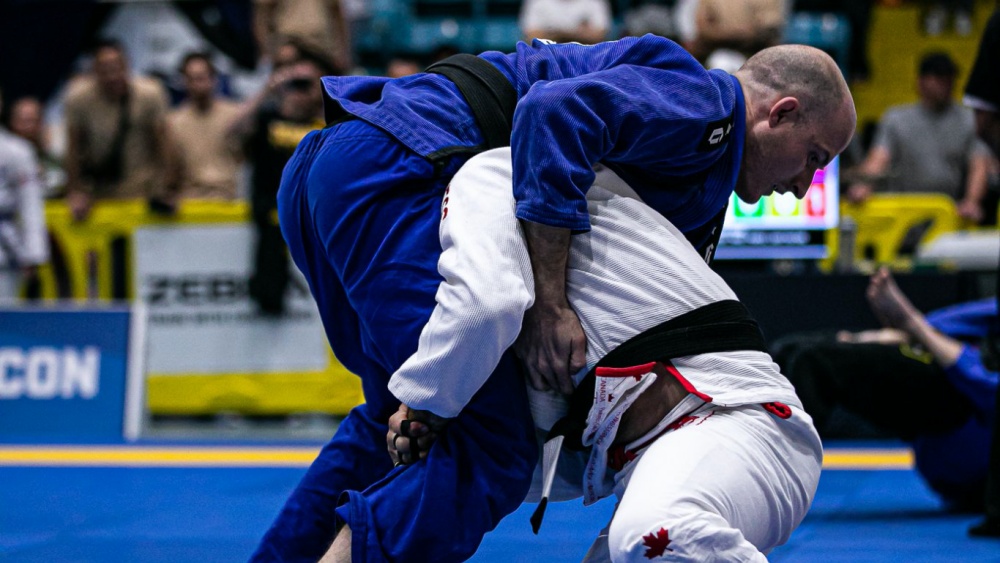Brazilian Jiu-Jitsu is a martial art that emphasizes ground combat, focusing on submissions and positional control. A big part of Jiu-Jitsu’s game involves taking the opponent to the ground. Many of today’s BJJ athletes adopt techniques from other grappling sports, especially in the standup, as it is not BJJ’s main strength. Incorporating wrestling techniques into BJJ can give practitioners a significant advantage, especially during the initial exchange. Today, Evolve Daily will review five wrestling techniques that have found their place in the sport of Brazilian Jiu-Jitsu.
1) Snapdown
The snapdown is a fundamental wrestling technique that can be seamlessly blended into BJJ. The movement involves using your hands to forcefully drag your opponent’s head down, thereby disrupting their posture and balance. The snapdown can be used as a setup for various submissions, including guillotines or front headlocks. Additionally, breaking your opponent’s posture by pulling it down gives you an easy path into other dominant positions or set up takedowns.
An important tip when doing snapdowns is to ensure you have a strong grip on the back of your opponent’s neck or head. Don’t be afraid to leverage your weight and use a quick downward motion to make them lose balance. It’s essential to stay close and capitalize on their compromised posture as soon as you can.
2) Arm Drag
The arm drag is a simple but effective technique where you control and pull your opponent’s arm across their body, which gives you access to attack at an angle. The goal of the arm drag is to force the opponent to expose either their side or their back, and from there, you can initiate your attacks. In terms of application, the arm drag can be a path to taking your opponent’s back, one of the most dominant positions in the sport. It can also be used to set up sweeps from guard positions or to counter an opponent’s aggressive grip.
It is critical to grip your opponent’s wrist firmly with one hand and use your other hand to control the tricep or elbow. Alternatively, you can cup near the opponent’s armpit for greater control. Next, pull their arm across their body while simultaneously moving at an angle. Doing this will expose their side or back easily.
This technique involves grabbing one of your opponent’s legs and using it to off-balance and take them down. This is by far the most popular takedown in BJJ. It is relatively low risk and does not require unique attributes to pull off. The single leg takedown is versatile because it allows for a controlled descent to the mat. Once the takedown is completed, you can easily transition to various top pins, including side control, knee on belly, or north-south.
Changing your level to get below your opponent is a good idea. Grip the back of their knee or thigh with one hand, while your other arm wraps around their leg. Drive forward and use your head to push against their body, taking them down. Always be mindful of your head position as it is a prime target for guillotine chokes.
The double leg takedown is a powerful wrestling technique where you grab both of your opponent’s legs as you cut an angle to bring them to the ground. This is one of the cooler techniques in grappling and is a favorite of MMA legend Georges St-Pierre.
In BJJ and other grappling sports, the double leg takedown offers a direct path to take someone down. It’s a technique that relies on explosiveness and timing, as you are attacking your opponent from the front. Once executed perfectly, it can lead to dominant positions like the mount or side control. It is also a beneficial move to do in MMA and self-defense situations. As a general rule, it is best to move at an angle once you secure the opponent’s hip; this will cause you to land to the side instead of directly toward your opponent. The last thing we want to happen is to fall inside the opponent’s closed guard after taking them down.
An important tip is to change your level and shoot toward your opponent, aiming to get your shoulders to their belly or hip. Wrap both arms around their legs, driving forward and lifting them off their feet, then use your momentum to crash them to the mat.
5) Sprawl
The sprawl is a defensive wrestling technique used to counter takedowns, mainly against shots like the double or single leg. The central premise of the sprawl is to keep your hips at a safe distance as you use your body to block their attack.
A well-timed sprawl can prevent an opponent’s takedown, allowing you to maintain top position and open up avenues for counterattack. It’s a vital move for those who want to keep the fight standing or establish dominance early in a match.
As your opponent shoots in for a shot, move your hips backwards and widen your base by spreading your legs out, “sprawling” your weight onto them. Use this opportunity to apply pressure towards their back by blocking with your chest and arms. Once you successfully defend the takedown, the next goal is to move to a better position (usually going to the back or getting a front headlock) to prevent them from reshooting.
Building A System
Think of these techniques as the cornerstone of your standup repertoire. We encourage you to practice these techniques consistently for the next couple of months, preferably drilling on both sides. Slowly integrate them into your sparring rounds and get your reps in every time you train.
Conclusion
While Brazilian Jiu-Jitsu and wrestling are two different grappling styles, the integration of wrestling techniques into BJJ provides practitioners a better and more well-rounded skill set to take someone down. By understanding and mastering moves like the snapdown, arm drag, sprawl, and takedowns, you can build a comprehensive standup game that will surely level up your Jiu-Jitsu.
You may also like:

















